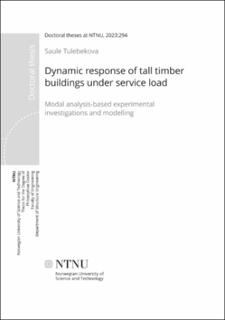| dc.contributor.advisor | Malo, Kjell Arne | |
| dc.contributor.advisor | Rønnquist, Anders | |
| dc.contributor.author | Tulebekova, Saule | |
| dc.date.accessioned | 2023-10-17T12:40:37Z | |
| dc.date.available | 2023-10-17T12:40:37Z | |
| dc.date.issued | 2023 | |
| dc.identifier.isbn | 978-82-326-7287-5 | |
| dc.identifier.issn | 2703-8084 | |
| dc.identifier.uri | https://hdl.handle.net/11250/3097033 | |
| dc.description.abstract | The rising awareness of sustainability importance has led to wider adoption of timber in structural design. While there is a growing number of multi-storey timber buildings, there is still a lack of confidence by designers in the use of timber for tall building constructions due to limited knowledge of their dynamic response under serviceability level loading. Generally tall timber buildings are able to resist ultimate state loads but are naturally susceptible to wind-induced excitation due to intrinsically low density and low stiffness. While wind-induced vibrations do not usually threaten the structural integrity of the building, the comfort criteria might become a significant issue. A lack of reliable data for modelling is considered as one of the main barriers to a wider application of timber in tall buildings. Therefore, this thesis aims to contribute to a better understanding of tall timber building dynamic response under serviceability level loading. The objectives of the thesis include experimental full-scale dynamic identification of tall timber buildings using ambient and forced vibration tests and the development of representative finite element models which are able to predict the vibration response of tall timber buildings.
Firstly, an ambient vibration testing campaign was conducted on seven multi-storey CLT buildings ranging between 9-13 storeys. Using the output-only stochastic subspace identification technique, accurate estimations of the natural frequencies and mode shapes were obtained from the ambient vibration measurements and the identified damping ratios were in the range between 1%-2%.
Secondly, long-term ambient vibration testing and forced vibration testing campaigns were conducted on an 18-storey glulam frame building. The output-only techniques were combined with the modal decomposition tool to process nonstationary data from ambient vibration measurements. The identified natural frequencies were quite stable and similar to their counterparts from forced vibration tests. An amplitude-dependent behaviour of damping ratios was observed based on forced vibration tests, which has significant implications on the design of tall timber building response under wind-induced loading, where damping plays an important role. The range of damping variation was between 0.5%-3.0% for the first two modes of vibration.
Thirdly, finite element models of the instrumented buildings were developed. A focus on the stiffness of connections and non-structural elements and their impact on global modal response was made. The effect of stiffness of connections in tall timber buildings is usually omitted by the designers and simplified assumptions of rigid or pinned connections are made. It was demonstrated that the stiffness of connections can have a significant impact on the global modal response of tall timber buildings. Moreover, the non-structural elements in tall glulam frame buildings have a partial stiffness contribution to the building modal response.
The results of the extensive tall timber buildings measurement campaign contribute significantly to the limited database of existing tall timber buildings’ dynamic properties. Moreover, the knowledge of damping properties in CLT and glulam frame buildings has been significantly extended. The proposed modelling approach is able to accurately predict the modal properties of tall timber buildings and can serve as a useful guideline for practising engineers in the development of their prediction models of tall timber buildings under serviceability level loading. | en_US |
| dc.language.iso | eng | en_US |
| dc.publisher | NTNU | en_US |
| dc.relation.ispartofseries | Doctoral theses at NTNU;2023:294 | |
| dc.relation.haspart | Paper 1: Tulebekova, Saule; Malo, Kjell Arne; Rønnquist, Anders. Dynamic identification and model calibration of connection stiffness in multi-storey cross-laminated timber buildings. Journal of Building Engineering 2023 ;Volum 72. This is an open access article under the CC BY license (http://creativecommons.org/licenses/by/4.0/). | en_US |
| dc.relation.haspart | Paper 2: Tulebekova, Saule; Malo, Kjell Arne; Rønnquist, Anders; Nåvik, Petter Juell. Modeling stiffness of connections and non-structural elements for dynamic response of taller glulam timber frame buildings. Engineering structures 2022 ;Volum 261. s. -This is an open access article under the CC BY license (http://creativecommons.org/licenses/by/4.0/). | en_US |
| dc.relation.haspart | Paper 3: Tulebekova, Saule; Ao, Wai Kei; Pavic, Aleksandar; Malo, Kjell Arne; Rønnquist, Anders. Identification of modal properties of a tall glue-laminated timber frame building under long-term ambient vibrations and forced vibrations. This paper is submitted for publication and is therefore not included. | en_US |
| dc.relation.haspart | Paper 4: Tulebekova, Saule; Malo, Kjell Arne; Rønnquist, Anders; Nåvik, Petter. Investigation of Long-Term Modal Properties of a Tall Glue-Laminated Timber Frame Building Under Environmental Variations. World Conference on Timber Engineering 2023 (WCTE 2023). Oslo, June 2023. Copyright © 2023 proceedings.com All Rights Reserved. | en_US |
| dc.title | Dynamic response of tall timber buildings under service load. Modal analysis-based experimental investigations and modelling | en_US |
| dc.type | Doctoral thesis | en_US |
| dc.subject.nsi | VDP::Teknologi: 500::Bygningsfag: 530::Konstruksjonsteknologi: 533 | en_US |

